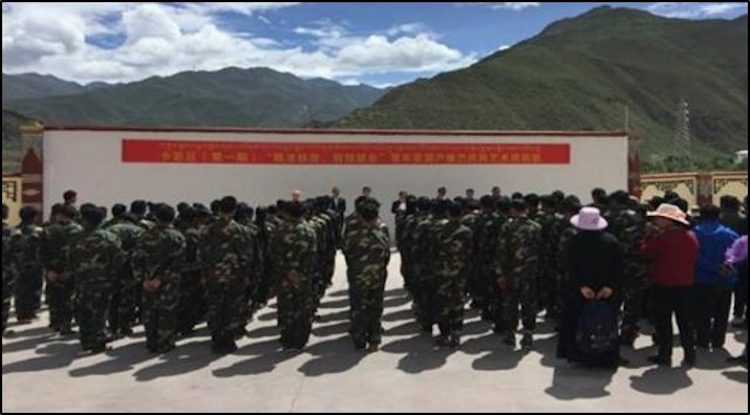By Choekyi Lhamo
DHARAMSHALA, Sept. 23: Following the news of China’s coercive labor programs in Tibet, more than 60 parliamentarians from 16 countries are demanding urgent action from the International governments to condemn the Chinese government.
“We call upon our governments to take immediate action to condemn these atrocities and to prevent further human rights abuses,” say the parliamentarians, who are members of The Inter-Parliamentary Alliance on China, which works to reform how democratic countries deal with China.
China has reportedly conducted mass transfer of Tibetans within Tibet and other parts of China according to Reuters’ finding from a hundred state media reports released between 2016- 2020 on Tuesday. It cited Tibet’s regional government website last month that confirmed almost half a million were trained in the first 7 months of 2020. Almost 50,000 Tibetans have been transferred for jobs within Tibet and several thousand sent to other parts of China.
“These recent announcements dramatically and dangerously expand these programs, including ‘thought training’ with the government’s coordination, and represent a dangerous escalation,” said Matteo Mecacci, President of the International Campaign for Tibet.
The quota available for rural labourers aims for a rapid expansion of an initiative to find loyal workers for the Chinese industry. The report claimed that many end up in low paid work including textile manufacturing, construction, and agriculture. It is one of China’s key plans to boost the economy but activist groups claim that the programs largely conduct ideological training.
China’s Ministry of Foreign Affairs in a statement to Reuters denied the involvement of forced labour and said that workers are predominantly volunteers and have been adequately compensated, “What these people with ulterior motives are calling ‘forced labor’ simply does not exist. We hope the international community will distinguish right from wrong, respect facts, and not be fooled by lies.”
The Tibetan programs are growing over the region as similar projects were detected in Xinjiang over the last years where some are linked to mass detention centers. International reports estimate that around a million ethnic Uyghurs have been subjected to ideological education in detention camps. China first denied the existence of these camps and later claimed that they are vocational and education centers.
There has been prior evidence of military-style labour camps in Tibet, but new mass scale programs suggest systematic transfers in and outside the region. State media described these operations in one of the villages near the Tibetan capital, Lhasa. Chinese officials carried out more than a thousand anti-separatism education sessions which allowed the “people of all ethnic groups to feel the care and concern of the Party Central Committee,” referring to China’s ruling Communist Party.
Both Xinjiang and Tibet models have an important link with the former Tibet Communist Party Secretary Chen Quanguo who took over Xinjiang in 2016 and expanded the camp system. The report also made reference to unspecified punishments for officials who miss out on their quotas; some programs call for “strict reward and punishment measures” for workers.











2 Responses
When something doesn’t work, repeating it endlessly is somewhat futile. In terms of the current Sikong, given his education, there is always going to be distrust in negotiations in that he is being manipulated. It’s best when leaders in these smaller entities stay neutral in terms of their global affiliations. Perhaps this was alluded to in the Noodlemaker of Kalimpong? Rest assured, Xi’s Harvard educated daughter plays a role behind the scenes. As for the vast majority of Tibetan people, the question remains is it a better option to be a refugee or figure out how to make things work within the system. Think about it, most people who converted to Buddhism in India did so because they were persecuted by the caste system and it was a way out of samsara. Later on, many of the same converted to Islam with the Mughals. So just like the Dalai Lama’s story, Tibet, Xinjiang and Taiwan are very much tied together in this. Have the local Taiwanese accepted the KMT that fled there en masse or do they have some derogatory term they use?
Maluna a’e o na lahui apau ke ola ke kanaka.
It is time to review our China policy as the middle path approach, which we have considered to be the golden path has not been able to achieve any substantial result after several rounds of fruitless talks with China. There is nothing wrong with the middle path policy, but it is being hoped and expected that China will see the wisdom and merit in this policy and resolve the Tibetan issue honorably for mutual benefits. To be honest, this is not going to happen so long there is CCP and the leaders like we are currently seeing on the TV screen, all over the world.
Tibet supporters and friends are sometime in a dilemma, not knowing what to do when there is no clear result after many years of negotiations. Many friends and well wishers of Tibetans are getting wrong message and signals today, as we are hoping against the hope to make deals with a regime who shows no interest in peaceful end to the Tibetan issues. The question arises in the minds of many people, whether or not there can be a negotiated settlement to the Tibet issue. The people are waiting for an answer from the present Sikyong before his tenures end this year.